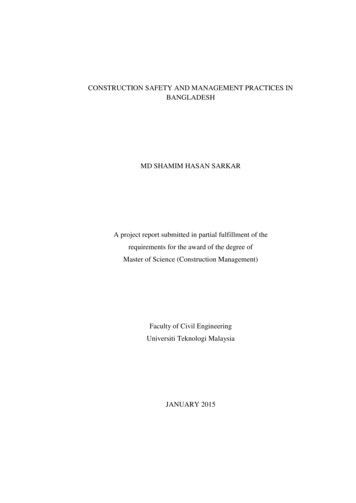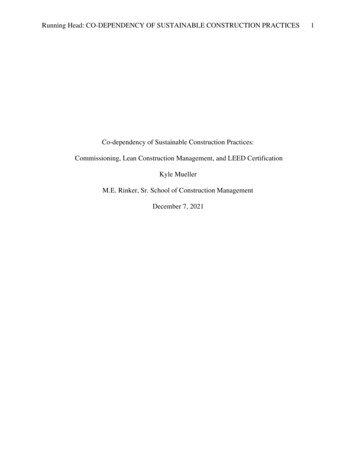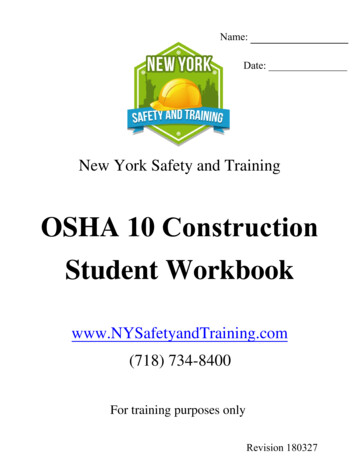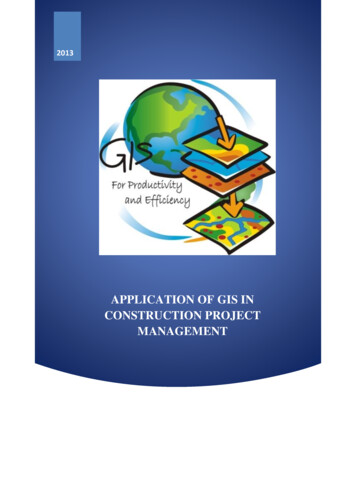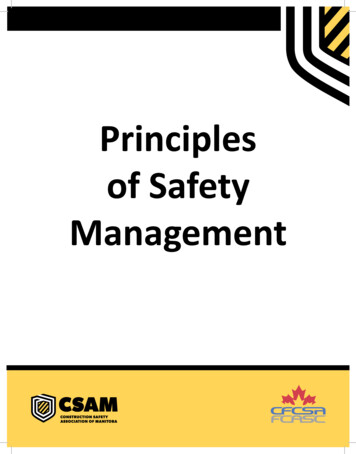
Transcription
Principlesof SafetyManagement
Table of ContentsAcknowledgements .3Disclaimer. 3Copyright . 3Section 1.4Safety Policy . 4Assignment of Responsibilities and Accountability for Safety. 5Section 2.6Identification of Hazards . 6Safety H.I.T. List. 7Occupational Safety and Health Requirements for Contracted Work . 8Contractor Compliance Declaration . 9Section 3.10Safe Work Practice . 10Section 4.12Safe Job Procedure . 12Section 5.14Safety Rules . 14Disciplinary Action Notice . 15Section 6.16Personal Protective Equipment Policy . 16Section 7.17Maintenance Policy. 17Section 8.18Training and Communication Policy . 18New Worker Orientation . 19Report of Education Program Meeting . 20Committee Minute Form . 21Section 9.22Inspection Policy . 22Inspection Checklist . 23Section 10 .24Incident Investigation Policy . 24Incident/Near Miss Report. 251
Section 11 .27Emergency Preparedness Policy . 27Section 12 .29Safety Statistics and Records Policy . 29Safety Summary . 30First Aid and Treatment Record . 31Section 13 .32Legislation Policy . 32Section 14 .33Workplace Safety and Health (WSH) Committee Terms of Reference. 33Hearing Conservation Program. 36Lockout/Tagout Policy . 37Working Alone or in Isolation Policy . 38WHMIS Guidelines . 39Operator/Training and Verification Policy . 40Musculoskeletal Injury Prevention Policy . 41Harrassment Prevention Policy. 42Violence Prevention Policy . 432
AcknowledgementsThe Construction Safety Association of Manitoba (CSAM) extends its sincere appreciation to the fellowCanadian Federation of Construction Safety Associations (CFCSA) members who graciously providedresources, information, and expertise for the preparation of this program.Construction Safety Association of ManitobaThe Construction Safety Association of Manitoba is a non-profit organization run by and for the buildingconstruction industry in Manitoba, with governance provided by the Winnipeg ConstructionAssociation’s Board of Directors and the CSAM Advisory Committee.Established in 1989, CSAM has earned the reputation as a leader in the safety landscape of Manitoba, aswell as within the CFCSA. This reputation continues to be fueled by the association’s focus on providingexceptional customer service, quality, and value for its clients.CSAM’s prime objective through this course is to provide quality advice to construction employers andemployees, to reduce both human and financial costs in the construction industry.DisclaimerThe information presented in this publication is intended for general use and may not apply to everycircumstance. It is not a definitive guide to government regulations and does not relieve persons usingthis publication from their responsibilities under applicable legislation. The Construction SafetyAssociation of Manitoba does not guarantee the accuracy of, nor assume liability for, the informationpresented here.Copyright 2020 Construction Safety Association of ManitobaThis publication is the property of the Construction Safety Association of Manitoba. Reproduction in anyform, by any means, in whole or in part, or use of this publication outside of CSAM’s educationalprograms is prohibited without express written consent.3
Section 1Safety PolicyThe safety and health of the employees of The Company is of vital importance. Safety is a conditionof employment with our company and shall not be sacrificed for the sake of expediency.It is our belief that all incidents can be prevented, and every effort shall be made to: Identify hazards Communicate hazard information to employees Control, eliminate, or reduce the risk of those hazardsAs outlined in our company manual, safety is a shared responsibility by all employees and shall be anintegral component of work activities — together we can create a positive safety culture and ensurea safe workplace.All employees will be expected to fulfill their safety responsibilities and to follow our company safetymanual.Employees’ legislated rights Right to refuse – dangerous work Right to know – about safety and health hazards in the workplace Right to participate – in safety and health activities Right to work without being subject to discriminatory actionThe Company recognizes the importance of active involvement in our company safety program andwill ensure that this manual and our policies and procedures are reviewed and updated on a regularbasis. At minimum, our company safety program will be audited on an annual basis to the COR national standard and reviewed every three years as required under the Workplace Safety and Health(WSH) Act.Management, safety and health committee members, and employees will abide by our companysafety manual and the WSH Act and Regulation.We recognize that the responsibilities for safety and health are shared, thus we encourage andexpect complete, active participation by everyone.Through conscientious contribution and continuous wholehearted support, we can, and will, improveour safety performance and assure a healthy, happy, and safe future for all concerned.Owner4Date
Assignment of Responsibilities and Accountability for SafetyOwner Provide a safe workplace Provide leadership by personal example Establish and maintain a safety program,ensuring a comprehensive review everythree yearsManagers Provide leadership by personal example Ensure compliance with WSH Legislation Identify hazards Tell others about the hazardso employeeso clientso others affectedSafety committee/worker safety representative Provide leadership by personal example Assist in employee safety issues Assist in identification of hazardso inspections/hazard assessmentso investigations Assist in the control or elimination ofhazardsEmployees Report hazards or unsafe conditions Correct hazards or unsafe conditions Report all injuries and incidents Comply with company safety program Wear required PPEContractors Complete a contractor compliancedeclaration Advise the prime/owner of any othercontractors entering the worksite Complete a safety orientation and hazardassessment prior to start up Ensure compliance with WSH LegislationEnsure proper training of employeesEnsure proper PPE is availableEnsure incidents are investigatedEnsure injuries are reported to WSH andWCB as required Control or eliminate hazardsProvide training as appropriateEnsure PPE is worn as requiredEnforce PPE is worn as required Suggest and advise of PPE requirementsand/or purchase Coordinate toolbox talks for employees Participate with others exercising a dutyunder the WSH Act Follow instructions and training receivedUse tools and equipment as intendedParticipate in toolbox talksMake safety suggestionsSet a good exampleParticipate in inspections Comply with the WSH Act and RegulationWear required protective equipmentEnsure workers are adequately trainedFollow all safe work practices and jobprocedures5
Section 2Identification of HazardsThe identification of hazards is a legal responsibility and a very important component of accidentprevention. As such, we will do all that is reasonably practicable to ensure hazards are identified,prioritized, communicated to appropriate people, and controlled to reduce their risk.For the purpose of identifying hazards, at minimum, The Company will conduct: Hazard assessments Inspections Incident investigationsUpon identification of a hazard, the following hazard priority ranking shall be used to help determinethe necessary control measures:Severity1. Immediate danger (death or disaster)2. Serious (major injury or damage)3. Minor (non-serious injury or damage)4. Negligible (first aid or less)5. Not applicableProbabilityA. Probable (immediately or soon)B. Reasonably probable (eventually)C. Remote (could at some point)D. Extremely remote (not likely)Management, safety and health committee members, and employees will abide by our identificationof hazards directive and the Workplace Safety and Health (WSH) Act and Regulation.Owner6Date
Safety H.I.T. List7
Occupational Safety and Health Requirements for Contracted WorkPurposeThe Company places a high priority on safety and health and requires all contracted parties to place thesame level of priority on safety and health during the execution of The Company’s work.The purpose of this policy is to ensure that all construction and maintenance work undertaken bycontracted parties of The Company will be undertaken in a safe manner in consideration of all hazardspresent, or associated with the work performed, in complete compliance with the WSH Act andRegulation.Contractual ClausesThe following clauses will be deemed to be included in the contract between The Company and thesuccessful contractor: Contractor is COR Certified or holds a current safety program registration issued by theConstruction Safety Association of Manitoba. Contractor is aware of and acknowledges its legal duties and responsibilities as an employerunder sections 4 and 7.4 (if applicable) under the WSH Act and shall ensure that the servicesprovided are carried out in accordance with the Act and all applicable Regulation. Contractor shall ensure that its employees, agents, and subcontractors are properly qualified,trained, and competent to perform the services. Contractor shall ensure adequate supervision and worker safety representation as outlined inthe WSH Act. Contractor shall conduct a pre-job hazard assessment and submit a copy of the results to TheCompany prior to start-up. Contractor shall allow The Company the right to inspect and audit site conditions and allpertinent safety performance records for the purpose of measuring adherence to The Companysafety and health objectives and compliance with the contractual obligations herein (*however,it is clearly understood that this will not be deemed to be relating to execution or coordinationof contractor activities. For greater certainty, the contractor is the sole person responsible forthe execution and coordination of work.) Contractor acknowledges that failure to comply with The Company’s safety and healthrequirements shall be cause for either immediate termination or suspension of the work untilthe deficiency, in The Company’s sole opinion is rectified, at no cost to The Company. In eithercase without prejudice to The Company’s rights to remedies or damages for such failure. Contractor is responsible to obtain Workers Compensation Board of Manitoba (WCB) coverageand remain in good standing with the WCB for the duration of the project.8
Contractor Compliance DeclarationWith respect to the objects and purposes of ensuring, so far as reasonably practicable, that allconstruction and maintenance work undertaken by contracted parties of The Company will beundertaken in a safe manner, the following declaration must be signed and submitted.Submitted to:Company rep:Company name:Address:The Company InformationCOR Certification #:Safety Program Registration #:DeclarationAs required by all employers in the province of Manitoba, I have obtained current copies of theWorkplace Safety and Health (WSH) Act and Regulation.As required by all employers in the province of Manitoba, I will ensure workers are supervised by acompetent supervisor, familiar with the WSH Act and Regulation.As required by all persons in the province of Manitoba, I will share required information with the owner,prime contractor, and those affected, necessary to identify and control existing and potential hazards. Iwill conduct a pre-job hazard assessment and submit a copy to The Company prior to start-up.To the best of my knowledge, I and my company employees meet the minimum safety trainingrequirements as outlined in Manitoba’s WSH legislation.My company has obtained coverage through the WCB and will remain in good standing with the WCBfor the duration of the project.Print name:Signature:Print title:Date:Site contact:Phone #:9
Section 3Safe Work PracticeDrillsHow do you select the proper bit or attachment? Follow manufacturers' instructions when selecting and using a bit or attachment, especiallywith unfamiliar drills or work. Select the bit or attachment suitable for the size of the drill and the work being done. Ensure that the bit or attachments are properly seated and tightened in the chuck. Use only bits and attachments that turn true. Use the auxiliary (second) handle for larger work or continuous operation.What should you do when working with powered hand drills? Wear safety glasses or a face shield (with safety glasses or goggles). Keep drill air vents clear to maintain adequate ventilation. Keep drill bits sharp always. Keep all cords clear of the cutting area during use. Inspect for frays or damage before eachuse. Disconnect power supply before changing or adjusting bit or attachments. Tighten the chuck securely. Remove chuck key before starting drill. Secure work piece being drilled to prevent movement.10
Slow the rate of feed just before breaking through the surface.Drill a small "pilot" hole before drilling large holes.What should you do when working with small pieces? Clamp stock so work will not twist or spin. Do not drill with one hand while holding the material with the other.What should you avoid when working with powered hand drills? Do not use a bent drill bit. Do not exceed the manufacturer's recommended maximum drilling capacities. Do not use a hole saw cutter without the pilot drill. Do not use high speed steel (HSS) bits without cooling or using lubrication. Do not attempt to free a jammed bit by starting and stopping the drill. Unplug the drill andthen remove the bit from the work piece. Do not reach under or around stock being drilled. Do not overreach. Always keep proper footing and balance. Do not raise or lower the drill by its power cord. Do not use in wet or muddy locations. Use a nonpowered drill instead. Do not use excessive force to drill into hard material. Reduce drill speed if possible.11
Section 4Safe Job ProcedureLockout/tagout for company vehiclesDepartment:Written by:THE COMPANYHazards present:Serious injury fromaccident or malfunctionElectrocutionFugitive emission ofcontrolled substanceApproved by:COMMITTEETools, equipment, and PPE requiredfor the jobLockout tagsVehicle keysTapeDate created:Date of last revision:Pre-request/additional trainingrequired:**Restrictions and additional information/requirements1.2.3.4.5.6.7.8.9.Steps to Complete the Task SafelyWhile in use, if the company vehicle is deemed to1. Thorough inspection or observation prior tobe unsafe to operate, immediately stop use.use, if the company vehicle is deemed to bea. If on a road or highway, signal, safely pullunsafe to operate, DO NOT USE.over off the road as quickly as possible,put the vehicle in park and turn off theengine.b. If the vehicle itself presents a hazard bysmoke, fire, fugitive emissions, or similar,exit the vehicle, maintain a safe distance,and call 911.Using an orange lockout tag, indicate why the vehicle is being removed from service (tags are located inthe staff room as well as in the safety manual in the vehicle)Place the BOTTOM of the lockout tag on the inside of the driver’s side window of the vehicleLock the vehicleAttach the remaining part of the tag to the keys for the vehicleTurn in the keys, with the lockout tag to the managerThe manager will schedule maintenance or repair for the company vehicle as necessaryOnce the maintenance has been completed, the manager will remove the tag and put the vehicle back inserviceAll records including the lockout tag and the service/repair records must be submitted to a committeeco-chair and kept on fileGuidance anitoba Workplace Safety and Health RegulationM. R. 217/2006 Part: 1612
Safe Job Procedure“Task name”Department:Hazards present:Written by:Approved by:Tools, equipment, and PPE requiredfor the jobDate created:Date of last revision:Pre-request/additional trainingrequired:**Restrictions and additional information/requirementsSteps to Complete the Task SafelyGuidance anitoba Workplace Safety and Health RegulationM. R. 217/2006 Part:13
Section 5Safety RulesThe following safety rules have been developed to reduce the risk of an incident occurring. Allemployees will be expected to know and follow our safety rules, while working on behalf of ourcompany.General safety rules Walkways and work areas must be kept free of obstructions at all times. Appropriate footwear will be worn in the workplace. PPE provided as a control for a particular hazard, will be worn as specified. No fighting, horseplay, practical jokes, or other interfering with other workers. No alcohol or illegal drugs (including be in possession of or under the influence of). Perform all work in accordance with safe work practices/procedures and managementdirection. All incidents will be immediately reported to management. Unsafe acts, unsafe conditions, and near misses will be reported to management promptly. Equipment and tools will be used in the manner they are intended to be used. Every employee will keep their work area neat, clean, and orderly. Smoking is not permitted inside The Company building or while attending client worksitelocations. This includes the use of e-cigarettes.Disciplinary actionThe Company reserves the right to administer whatever discipline is necessary to ensure safety rulesand regulations are complied with.Management has the authority to suspend an employee who willfully and knowingly disobeys ourcompany rules.First infraction - verbal warningSecond infraction - written warningThird infraction - sent home for that dayFourth infraction - indefinite suspension and/or terminationAll infractions will be documented, and a copy retained on file.Owner14Date
Disciplinary Action NoticeEmployee Name:Company:Date:Disciplinary action:1) Verbal warning2) Written warning3) Sent home for that day4) Indefinite suspension and/or terminationInfraction:Safety rulesPPEUnsafe use of tools or equipmentHarassmentViolenceInsubordinationUnsafe practice or procedureOtherComments:Employee Signature:Management Signature:All infractions will be documented, and a copy retained on the employee file.15
Section 6Personal Protective Equipment PolicyAll employees will use the appropriate personal protective equipment when(PPE) whenand whereand whereit is it isrequired. All employees will be expected to know and wear the required PPE.personalGenerally,protectivethis will beequipmentprescribed by:(PPE). Generally, this will be prescribed by: Workplace Safety and Health (WSH) Act and Regulation WorkplaceHealth– (WSH)Act and RegulationsSafety DataSafetySheetsand(WHMISSDS sheets) SafetyData SheetsOur companysafety(WHMISrules – SDS sheets) Ourcompanysafety rulesTo controla specifiedhazard To control a specified hazardAt all times when on a construction project, or when the nature of work requires, employees willAtwearall thetimesfollowingwhen onbasica constructionPPE:project, or when the nature of work requires, employees willwear theCSA-approvedfollowing basicPPE:hard hats CSA-approved safety footwear (green triangle, Grade 1 protective toe and ankle protection – CSA-approvedhard hatsno safety shoes) CSA-approvedfootwearLong pants andsafetysleevedshirts (green triangle, Grade 1 protective toe and ankle protection –no safety shoes)The followingLong pantsspecializedand sleevedPPE willshirtsbe required to be worn for the specific job or to control potentialhazards. As such, any person entering a construction site should have the following specialized PPEThereadilyfollowingavailablespecializedto wear: PPE will be required to be worn for the specific job or to control potentialhazards.As such,any person entering a construction site should have the following specialized PPE Safetyeyewearreadilyavailabletowear. Hearing protection High visibility vests SafetyGloveseyewear Hearing protection willHighbevisibilityAll PPEkept in vestsgood condition and maintained according to the manufacturer’s specifications.PPE usedGlovesmust conform to CSA and/or ANSI standards.All PPE will be kept in good condition and maintained according to the manufacturer’s specifications.PPEused must conform to CSA and/or ANSI standards.OwnerDateOwnerNotes:16Date
Section 7Maintenance PolicyAll tools, equipment, machinery, and vehicles are to be kept in a condition that will maximize thesafety of all personnel and maintained as per manufacturers specification.All employees will use tools and equipment in the way they are intended and will receive trainingand instruction in their safe operation. Employees will participate and apply the training received. DO NOT attempt to use any tool or equipment that you are not competent with or cannotuse safely.ASK management.Employees must report all observed defects to their supervisor and the defective item must be takenout of service immediately by attaching a lock and tag that identifies the defect. All necessary repairsare to be conducted by a qualified person.To accomplish our maintenance program goals, an inventory of all major tools, equipment,specialized protective equipment, machinery, and vehicles will be kept and updated. The results ofany repairs or pre-job inspections will be documented.To ensure our maintenance program is being implemented we will complete the following:1. Adherence to manufacturer’s specifications, standards, and regulations.2. The employees’ responsibility for inspecting all tools and equipment prior to using them.3. Frequency of inspections include: Pre-use inspections of vehicles Pre-use inspections of The Company aerial lifto Bi-annual inspection of aerial liftThe Company’s management will be responsible for the application of the maintenance program inhis/her area of responsibility.OwnerDate17
Section 8Training and Communication PolicyAll personnel have a legal duty to share required information that: May affect the safety, health, or welfare of others. Is necessary to identify and control existing and potential hazards.All personnel will continuously be on the lookout for hazards and if practicable, control themimmediately. Personnel are to immediately inform management, and those affected, of any situationin which they deem to be hazardous.Serious hazards and their controls will be discussed with all personnel as soon as reasonablypracticable. The hazards identified through hazard assessments, inspections, and investigations willalso be posted on the safety bulletin board.Notwithstanding the above, the following items will serve as our minimum guidelines to establishingan effective means of hazard communication: Management availability at all times Workplace safety and health committee Orientations Toolbox talks Job specific instruction and training WHMIS Posted and/or made readily available:o Safety manualo Applicable legislationo Emergency procedureso Emergency telephone numberso SDS sheetso Safe work practices/safe job proceduresOwner18Date
New Worker OrientationWorker Name:Introduction Company history Company policiesResponsibility for Safety Worker Supervisor ManagerEmergency Procedures Emergency phone Emergency phone numbers Fire Ambulance First aid kit (Location: ) AED (Location: ) Security/police Evacuation plan/muster pointGeneral Rules / Prohibited Activities Alcohol, drugs Horseplay, fighting Vehicle operation TheftPersonal Protective Equipment Hard hats Safety footwear Safety glasses Fall protection Respirators Hearing protectionReporting Procedures Reporting an incident/near miss Investigation forms First aid kit logsDate:Workers’ Rights Right to know Right to participate Right to work without being subject todiscriminatory act
The Construction Safety Association of Manitoba(CSAM) extends its sincere appreciation to the fellow . trained, and competent to perform the services. Contractor shall ensure adequate supervision and worker safety representation as outlined in . competent supervisor, familiar with the WSH Act and Regulation.
